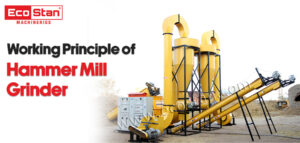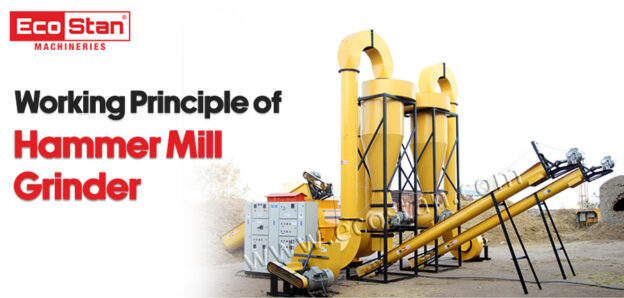ECOSTAN® Working Principle of Hammer Mill Grinder

A hammer mill grinder is an industrial tool used to reduce the size of different hard and solid materials by breaking and crushing them.
Several industries worldwide utilize a hammer mill grinder in their manufacturing procedure. In this blog, we will explore and learn about the working principle of a hammer mill grinder, its different types, and their applications.
To begin with, let’s find out what purpose these hammer mill grinders serve and what their advantages are.
Advantages Of a Hammer Mill Grinder
Hammer mill is a valuable material processing tool in the mining, chemical, food, cosmetic, and construction industries. These industries make use of hammer mills for several following advantages:
- A hammer mill consumes less power for its operations. Thus, it is a cost-effective machine.
- You can use it to crush and grind various types of materials at a higher angular velocity.
- Regardless of the grinding procedure, whether you need a hammer mill for primary, secondary, or tertiary grinding, the reduction ratio and capacity of a hammer mill will always be high.
- Due to the dynamic size reduction procedure, a hammer mill is most idle for brittle material.
- Anyone can install these machines easily for continuous operations.
- If you need to crush material to a specified top size, a hammer mill will make it possible without requiring any closed-circuit crushing system.
- The maintenance of a hammer mill is easy since it is smaller and doesn’t occupy a larger space.
Hammer Mill Principle: How Does It Works
Any standard hammer mill grinder includes:
- A feed hopper
- A rotary valve
- A crushing chamber
- A control box
- A few crushing hammers or knives
Though you will find different types and models of hammer mills, all of them will function on similar working principles.
The hammer mill will reduce any feed material in various sizes with hammers that strike the material with a powerful force and grind it down. These hammers are generally high-speed and high angular velocity rotating pieces of hardened steel inside the mill chamber.
Any hammer mill machine will work through the following principles:
Material feeding: As the first step, a suitable material will be fed through the feed hopper. After that, the material will enter the crushing chamber through a controlled or metered process, or in some cases, by gravity.
This specific process will always depend on the design of the hammer mill grinder.
Crushing of the material: After entering the mill chamber, several hammers will crush the material using high-speed rotations. The diameter of the screen size must be equal to that of the particles to allow them to pass through.
Or the grinding procedure will continue inside the mill chamber until the material is reduced to the required size. Make sure that the chamber will remain closed until the grinding operation is not complete.
Final product discharge: The final product will pass through perforated metal screens after grinding within the hammer mill machine chamber. At this point, the metal screens will allow the required particle sizes to pass through the bar gates while holding those of coarse materials.
After that, you can pack the final product or send it for further processing per your requirement.
However, the hammer mill principle is pretty straightforward; you must purchase only the best quality machine. It will ascertain its durability and best results with its grinding mechanism.
Different Types of Hammer Mills
The types of hammer mills are determined based on their industrial use. Below you will find a few of the most common hammer mill types based on industrial hammer mill use:
Gravity Discharge Industrial Hammer Mill: These hammer mills have swinging hammers mounted to the shaft. The size reduction procedure is done by both hammerings and with force produced by striking particles on particles. Product discharge is entirely subjected to gravity.
So, the final product is acquired from the bottom of these mills. Therefore, these mills are also known by the Bottom Discharge Mills name.
Pneumatic Discharge Hammer Mill: Though the hammering procedure in these mills is similar to those of gravity discharge hammer mills, the only difference is that these mills have thinner hammers and chamber walls. These mills have a plate dashboard that aids with the size reduction procedure.
The air evacuation procedure helps discharge the final product and enhances the overall output. These mills help with the size reduction of lighter materials such as paper, biomass, greenwood, etc.
Full Circle Screen Hammer Mill: These hammer mills use a rotating screen of 300 degrees to improve particle evacuation. A full-circle screen hammer mill is most suitable when grinding lightweight materials that do not need any initial grinding. Industries use these hammer mills for grinding spices, grass, etc.
Horizontal In-feed Hammer Mill: The hammering procedure begins by inserting materials from the side of these machines. Due to their aggressive functionality, these machines are most suitable for heavy particle grinding.
Lump Breakers: A lump breaker hammer mill differs entirely from any other hammer mill. This hammer mill doesn’t include swinging hammers but only a tiny fixed hammer planted on its shaft. The only purpose of this hammer mill is to smoothen the milled particles of powders and pastes.
Generally, sugar, dry chemicals, and cement industries use lump breakers for their hammer mill needs.
Hammer Mill Uses
In all kinds of industries, different hammer mill grinders serve various applications. Let’s know about them:
Production of intermediate grades of powders: Pharmaceutical and chemical industries use different types of hammer mills to produce intermediate-grade powders. The procedure includes gathering different materials and crushing them using a hammer mill grinder.
Grinding of legumes and other dry products: Hammer mills help food processing industries to grind different legumes and dry products. The primary materials include soya, nutshells, groundnuts, and beans. These materials are crushed using low hammer blows to remove hard nutshells.
Reducing the size of materials: Pharmaceutical industries use hammer mills to grind materials to turn them into micro size. The purpose is to grind materials to fit them into capsule packaging.
Supporting the formulation process: Hammer mills help speed up the formulation of the chemical dissolution procedure by dissolving the small-sized particles faster.
Mixing solid dry and fibrous material after milling: Hammer mills help mix two different solid powders. It helps with the production of a more consistent powder.
Enhancing activeness of substance ingredients: Hammer mills also help improve the activeness of components by slightly crushing them.
Fast and cost-effective recycling of materials: Scrapping purposes are easily fulfilled with the help of hammer mills. A hammer mill grinder can quickly grind, resize, and mix different materials for recycling purposes.
Bottom Line
To ensure the quality of your final product, regardless of your industry type, you must select a hammer mill grinder only from a trusted manufacturer or supplier.
Ecostan is one of the most renowned and promising names in hammer mill manufacturing. Hammer mills manufactured by Ecostan lead the market. Using advanced technology and producing hammer mill machines of the highest standard is the key to their hammer mill’s finest quality.
If you are considering purchasing a hammer mill grinder for your industry, visit Ecostan. Here you will find several hammer mill grinder options with different features and price ranges to meet your unique industrial requirements.


 Click to Play Video
Click to Play Video